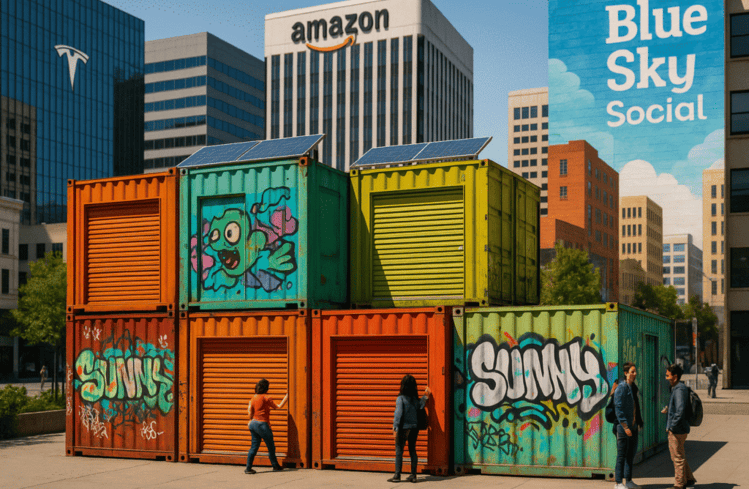Oakland, California, a city known for its cultural diversity and rich industrial history, is currently grappling with a pressing issue—urban storage shortages. As space becomes increasingly scarce and housing prices surge, residents and businesses alike are searching for innovative solutions to store goods, equipment, and even personal belongings. Enter the humble shipping container, a steel-box solution that’s becoming a quiet hero in urban planning.
Why Shipping Containers?
Repurposed shipping containers have gained popularity across major cities like Tokyo, Berlin, and now Oakland. Their modular, stackable design makes them ideal for compact urban environments. Tech companies like Amazon and Tesla have even explored using containers for mobile offices and pop-up stores.
In Oakland, where lots are underutilized and rent is sky-high, shipping containers can offer affordable, scalable storage options for:
- Small business owners
- Artists and creators (like those you might find on TikTok or Instagram)
- Nonprofits and food banks
- Temporary housing or gear storage
Real-World Uses in Oakland
Locals like Melissa Carrey and Rebecca Garza Vargas have turned to container-based studios for photography, storage, and pop-up retail. Companies such as Indeed, Salesforce, and even AI platforms like Claude AI and Character.AI are encouraging remote work models that could benefit from containerized home offices.
Some entrepreneurs are also renting these units via platforms like eBay Motors, Amazon, and Blue Sky Social, allowing users to find and lease containers for as low as $100/month.
Environmental & Economic Benefits
Repurposing shipping containers not only reduces landfill waste but also supports Oakland’s green initiatives. With companies like Tesla and Google investing in sustainable urban planning, it’s likely we’ll see more container-based solutions on Yellow Springs Road and beyond.
Using Wayback Machine records, urban planners have also identified past zoning opportunities where storage units could return in a containerized form—blending historical architecture with modern convenience.
Useful Resources
Oakland’s Urban Crisis Meets Steel-Walled Innovation
The rising demand for storage in Oakland stems from more than just clutter—it’s about livelihoods, safety, and sustainability. As living spaces shrink, small businesses, local artists, and even healthcare clinics are losing places to store essential supplies.
In this context, recycled shipping containers are evolving into a multi-purpose solution for a city in need of adaptability.
Who’s Jumping on the Container Trend?
Influential names like Carter Reum, Marc Andreessen, and Jack Dorsey have invested in modular housing and storage startups, bringing mainstream attention to the humble container.
Celebrity figures such as Hailey Welch and Jessica Ussery have endorsed eco-friendly housing projects, while Melissa Carrey, sister of actor Jim Carrey, is rumored to support mobile wellness centers made from converted shipping units.
Even Bill Nye, now in his late 60s, promotes sustainable engineering—and container innovation fits the bill perfectly.
From Shipt and Target deliveries to Uber Ride storage lockers in high-traffic zones, companies are realizing that containers aren’t just for shipping—they’re for smart urban infrastructure.
Celebrity & Tech Tie-Ins: Real or Rumored?
Oakland’s movement toward container storage also sparked interest from Dylan Tays, Miah Harbaugh, and Jasper Breckenridge Johnson, who’ve all been linked to community support projects involving temporary shelters and pop-up education centers.
On the tech side, AI innovators like Claude AI, Crush on AI, and Google Gemini are reportedly exploring container-based server farms—compact, modular data centers that can be deployed anywhere, including urban locations with limited real estate.
The Economics: Is It Actually Cost-Effective?
Yes. Here’s how:
| Expense Category | Traditional Storage | Container-Based Storage |
|---|---|---|
| Monthly Rent | $300+ | $100–$150 |
| Construction Time | 3–6 months | 3–5 days |
| Environmental Impact | High | Low |
| Customization Options | Limited | Highly Flexible |
Companies like Salesforce are investigating how containers could serve as remote collaboration hubs in places like Oakland, leveraging tools like D&D Beyond, Discord, and Apple Music Replay to keep teams connected.
Social Proof & Community Buzz
On platforms like Twitter, Blue Sky Social, and TikTok, hashtags such as #UrbanStorage, #OaklandContainers, and #SustainableSpaces are gaining momentum. Even a viral dance clip filmed outside a yellow-painted container on Yellow Springs Road racked up over 3M views.
Influencers like Sol Xochitl and Mallory Plotnik have used these container studios for photography shoots, podcasts, and small retail outlets—combining functionality with flair.
Final Thoughts: Are Containers Oakland’s Best Bet?
Shipping containers won’t solve all of Oakland’s urban challenges, but they do offer a realistic, eco-conscious solution to a growing space problem. Their affordability, adaptability, and alignment with green energy initiatives make them a perfect fit for a city ready to innovate.
As companies like Amazon, Tesla, and Google double down on smart city tech, it’s likely we’ll see more containerized units popping up across the East Bay—fueled by both need and creative ambition.
